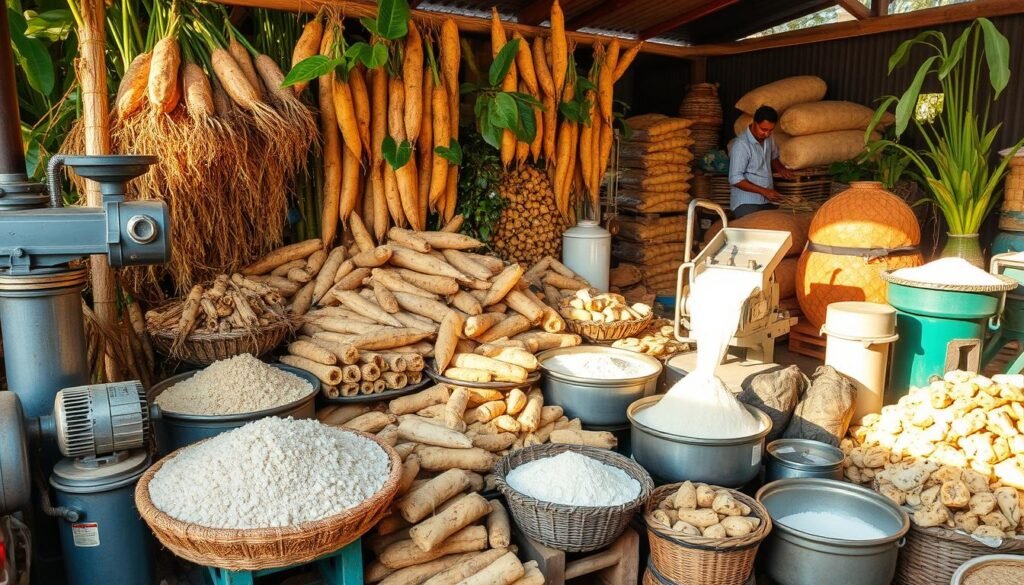Have we ever thought about why cassava, a simple root, is key in the fight for food security worldwide? It’s packed with nutrients and has many uses. This makes cassava a vital food for millions, especially in Africa, Asia, and South America.
Looking into advanced cassava processing shows us the power of both old and new methods. These methods turn this root into valuable items like cassava flour and starch. They help us meet the needs for more food, sustainability, and economic growth.
The journey of cassava from the earth to the market is both interesting and meaningful. It’s linked to culture and farming. Learning about this process helps us make better products, boosting the food industry’s value.
We’ll discover the details of cassava processing, from peeling to new solutions for producers worldwide. This will show us how to improve its transformation into quality products.
Key Takeaways
- Cassava deteriorates quickly, highlighting the importance of effective processing techniques.
- Processed cassava products range from dry items like chips and flour to moist versions such as attieke and chikwangue.
- Peeling cassava significantly reduces cyanide content, making it safer for consumption.
- Thinly sliced cassava chips dry more efficiently, enhancing shelf life and quality.
- Modern innovations in cassava starch production are addressing industry challenges in Thailand and beyond.
The Importance of Cassava in Global Food Security
Cassava is key to improving global food security, especially in tropical and subtropical areas. It’s a staple for nearly 500 million farmers and processors, crucial for food systems worldwide. Cassava is a vital food source for hundreds of millions, offering lots of calories and growing well in different climates.
Recent data shows that cassava production hit 315 million metric tons in 2021. Africa produced about 65% of this, showing its importance in food security. By 2025, 62% of cassava will still come from sub-Saharan Africa, showing its growing role.
Cassava’s ability to grow in tough conditions, like drought, makes it even more important. It stays nutritious even when it’s dry, making it a key part of food security plans. Working together, we can grow cassava-based industries, opening new markets and supporting local economies.
Improving cassava goes beyond local areas, aiming for a global vision. Support from development banks and international groups is crucial. This effort boosts food security and economic growth, especially in developing countries. By valuing cassava, we help achieve sustainable development and better food systems globally.
| Category | Global Statistics | Significance |
|---|---|---|
| Cassava Farmers and Processors | 500 million | Livelihood support |
| Global Production (2021) | 315 million metric tons | Essential food source |
| Africa’s Share of Production | 65% | Food security in vulnerable regions |
| Projected Production from Sub-Saharan Africa (2025) | 62% | Regional stability and food systems |
| Cassava Yield in Africa | 8.55 tons/ha | Efficient use of land resources |
Understanding Cassava: A Brief History and Its Varieties
Cassava, also known as manioc, has a long cassava history that goes back around 10,000 years to Brazil. It’s a key food for over 500 million people worldwide, providing a lot of carbohydrates. It was first taken to Africa and Asia in the 16th century.
Today, cassava varieties are vital for food and processing. There are two main types: bitter and sweet. Bitter cassava needs careful processing due to toxins, while sweet cassava is safer and used in many dishes.
Every year, the world grows about 160 million tons of cassava. Nigeria grows the most, and Thailand exports the most cassava starch. Cassava grows best in warm, tropical areas with the right conditions.
Knowing about the different cassava varieties is key for farmers and processors. Small farmers are crucial for keeping cassava production high. They face challenges like pests and diseases, but they also find ways to make cassava safe and tasty.
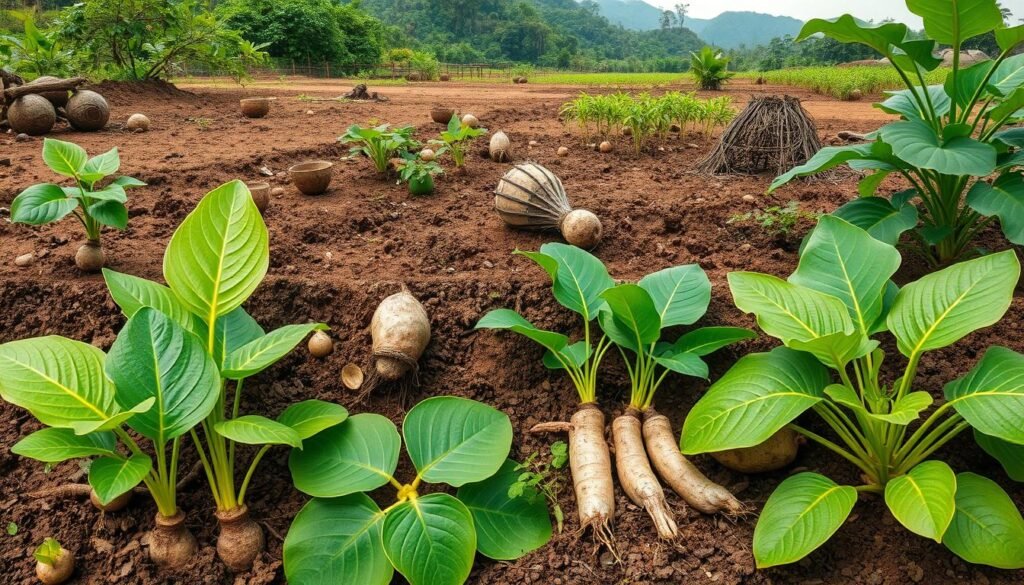
| Cassava Facts | Details |
|---|---|
| Global Production | Approximately 160 million tons annually |
| Main Producers | Nigeria (largest producer), Thailand (largest exporter) |
| Cultivation Conditions | Mean temperatures between 20°C and 29°C, 240 days of growth |
| Uses | Food, animal feed, industrial starch |
| Health Aspects | Small amounts of calcium, phosphorus, vitamin C, and dietary fibre |
| Cyanogenic Compounds | Present in varying amounts; must be processed safely |
Harvesting Methods: Traditional vs. Modern Techniques
Exploring cassava harvesting reveals two main methods: traditional and modern. Traditionally, people use hand tools like hoes and cutlasses. This method is rooted in local culture but often leads to lost roots and lower yields.
Efficiency in cassava production is key. The traditional way, though simple, can’t meet global demands. Without machinery, small farms face a heavy labour burden, leading to drudgery.
Modern techniques have changed harvesting. Machinery, like mechanical harvesters, cuts down on time and labour costs. These methods boost productivity and keep roots in better condition. They also prevent spoilage, which can happen quickly after harvesting.
The shift to modern methods is a big step forward. It improves the cassava value chain from field to market.
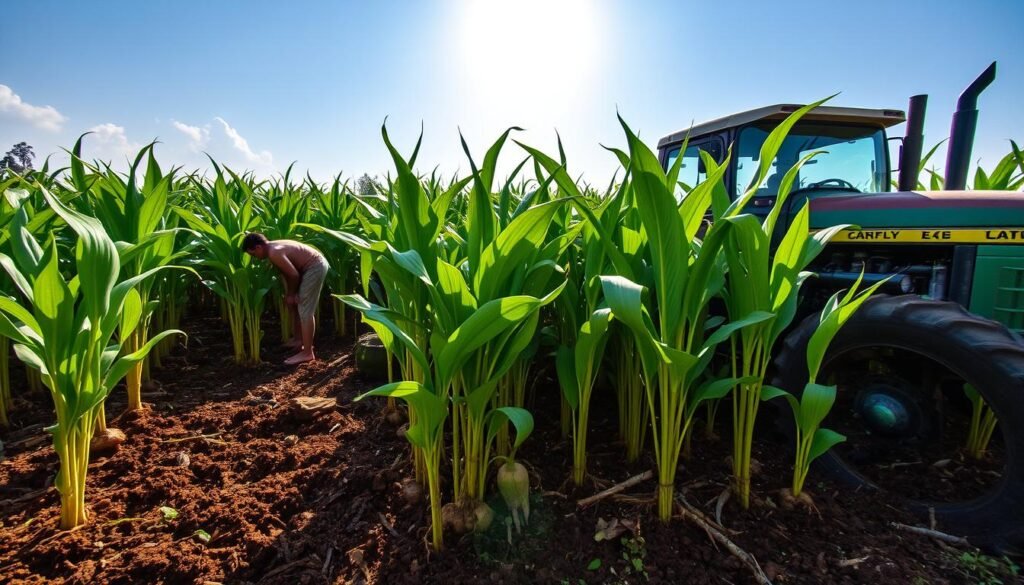
| Method | Advantages | Disadvantages |
|---|---|---|
| Traditional Harvesting |
|
|
| Modern Techniques |
|
|
Cassava Processing Techniques: Traditional and Modern Methods
Cassava processing is key to making the root into food. We’ll look at both old and new ways of peeling, grating, fermenting, and drying cassava.
Peeling and Grating: Key Steps in Cassava Preparation
The first steps in cassava processing are peeling and grating. Old methods use hands to remove tough outer layers and harmful compounds. This careful work makes the cassava safer and better tasting.
New methods use machines to speed up peeling and grating. This saves time but might not keep the quality as high.
Fermentation: Traditional Methods and Modern Applications
Fermentation is vital in cassava processing. Old ways let cassava ferment for over two days, making it taste better. But, some modern methods cut this time short to save money, risking food safety.
Good fermentation makes cassava taste great and last longer. Modern methods focus on the right temperature and time to get the best flavour.
Drying Techniques for Enhanced Shelf Life
The last step is drying, which keeps cassava fresh longer. Sun-drying is common in sunny places. New methods like oven drying control moisture better, keeping cassava fresh.
Getting the right moisture is key to stopping bacteria and keeping cassava good.
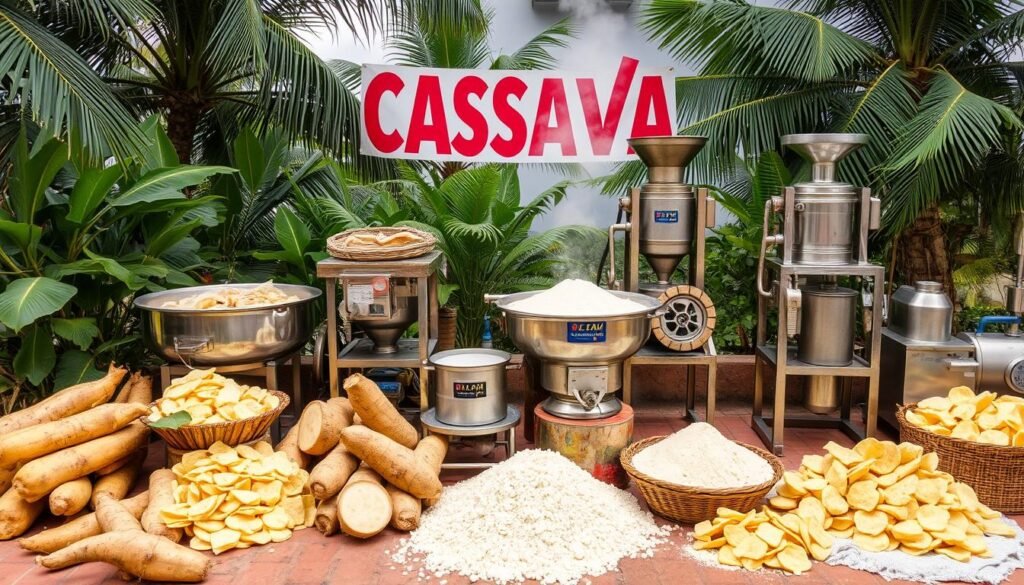
Cassava Processing, Cassava Flour, Cassava Starch, Industrial Cassava Processing
The industrial processing of cassava is key to making valuable products like cassava flour and starch. We look at the modern methods used to make these products of high quality. Cassava flour is a good substitute for wheat flour, especially in baked goods in Africa.
High Quality Cassava Flour Production for Industrial Use
To make top-notch cassava flour, the right processing is crucial. The process includes washing, peeling, and grinding the cassava into flour. The method used affects the flour’s quality. Wet processing makes the flour whiter and reduces sand, making it better for industrial use.
Cassava Starch Extraction: Processes and Uses
Extracting cassava starch involves several steps like washing and drying. Each step is important for a pure starch. The starch is mainly used in food, pharmaceuticals, and biofuels. New technologies have improved the extraction process, leading to better quality and more starch.
Technological Advances in Industrial Processing
New technologies are changing how cassava is processed. Companies are using better machines to boost productivity and meet quality standards. The use of ISO9001:2015 quality systems has made products more reliable. There’s also a move towards more mechanised processing to handle large amounts efficiently.
| Parameter | Traditional Methods | Modern Methods |
|---|---|---|
| Investment Cost | Low | High |
| Quality of Flour | Low whiteness, high sand content | Enhanced quality and yield |
| Environmental Impact | Wasteful, less sustainable practices | Recycling and waste-to-energy initiatives |
| Employment Opportunities | Limited | Over 2,000 people per factory |
These advancements in cassava processing show a trend towards innovation. As demand for cassava products grows worldwide, using modern methods to ensure quality is vital. It helps meet market needs and ensures sustainable food sources.
Market Trends in the Cassava Industry
The cassava industry is growing fast, with new trends showing its economic value. The global cassava flour market was worth about USD 4.74 billion in 2023. It’s expected to grow at a 6.3% CAGR from 2024 to 2030.
Conventional cassava flour made USD 3.03 billion in 2023. This is because it’s cheap and easy to find, especially in developing areas.
Distribution channels are changing due to more demand. Supermarkets and hypermarkets made USD 2.28 billion in 2023. This is because they have good supply chains and promotions.
Online sales of cassava flour are growing fast, at a 6.6% CAGR from 2024 to 2030. This is because shopping online is getting easier and more popular.
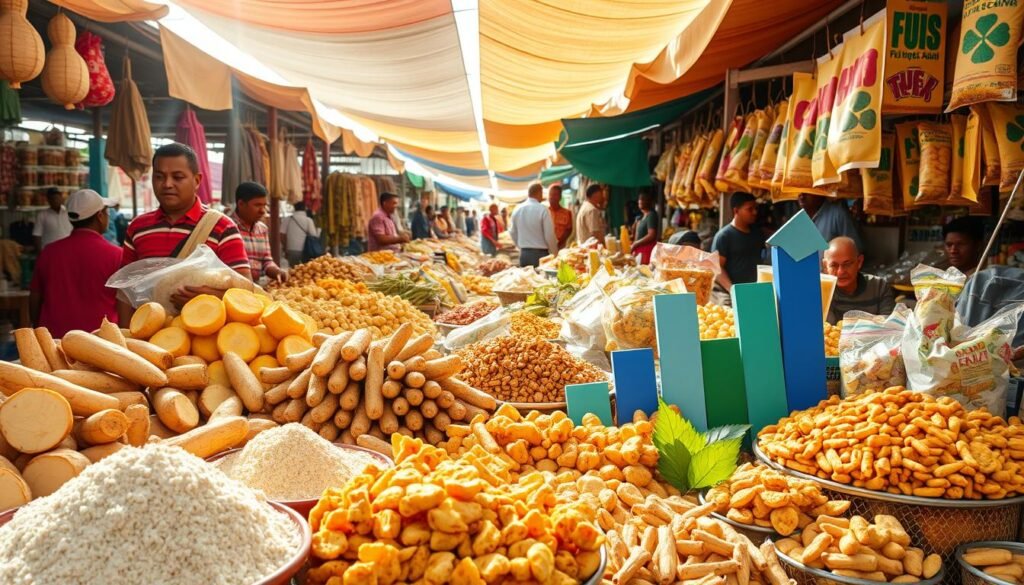
The cassava processing market is expected to grow at a 2.9% CAGR from 2024 to 2032. It will reach 368.53 million metric tonnes. The Asia Pacific region is growing the fastest, at a 3.3% CAGR.
India and Nigeria are also seeing big growth, with CAGRs of 3.9% and 3.7%, respectively. There’s also a big move towards cassava-derived ethanol, with a 3.4% CAGR forecasted from 2024 to 2032.
Several factors are driving these trends. People are becoming more health-conscious, leading to more demand for gluten-free products. New technologies and cassava products are also opening up new opportunities.
The food industry is growing, and there’s more focus on biofuels. These factors are boosting the cassava sector’s economic potential.
But the industry faces challenges like climate issues, pests, and price changes. Still, the outlook is positive. Countries like India, Nigeria, and Vietnam are making big contributions.
As we see the cassava industry grow, there are many chances to get involved. This brings excitement and a forward-thinking approach to this important crop.
The Role of Women in Cassava Processing
In Nigeria, women play a key role in cassava processing. They are responsible for about 70% of the work. This boosts local economies and helps communities through farming.
The Niger Delta region is a big part of this effort. It shows how important women are in farming.
Cassava is a good crop for women because it’s easy to grow. It helps them farm even when they don’t have much. But, women face many challenges in cassava farming.
They struggle to get credit and land. High costs for transport and labour make things harder. This can lead to low earnings.
Women often work with family or hire others for planting and harvesting. They also take care of their homes. This can be stressful but they focus on their families first.
We studied 120 women in North Central Nigeria. Most of them made Elubo, a cassava flour. They play a big part in keeping food safe and communities strong.
To help women, we need to improve their tools and access to resources. This can make their lives better and fairer in farming.
| Key Factors Affecting Women in Cassava Processing | Statistics |
|---|---|
| Women in processing and marketing | 70% responsible |
| Mean age of women processors | 44 years |
| Average household size | 5 persons |
| Participation in flour processing | 85% engaged |
| Major constraints faced | Inadequate land, high transportation costs, insufficient capital |
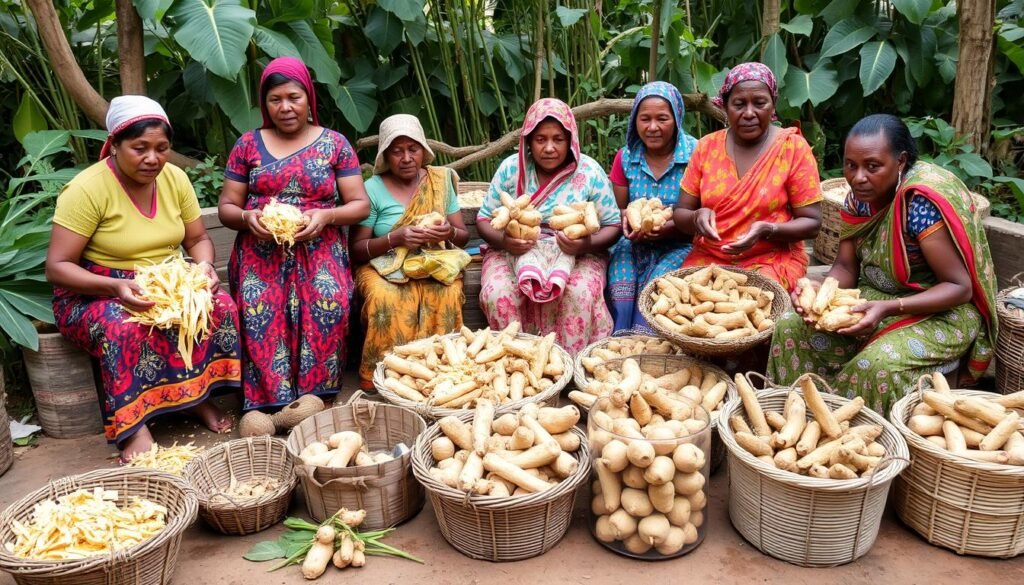
Investing in Cassava Processing Equipment: What You Need to Know
Investing in cassava processing equipment involves several key factors. We must assess the machinery’s fit for our local conditions. This means looking at our specific needs and the type of cassava we plan to use.
Cost analysis is crucial. We need to consider operating, maintenance, and potential savings. The cost of machinery can be high, but smaller flour processing machines start at around USD 50,000. This makes it a good option for new entrants.
There are different cassava processing methods, which affect the machinery needed. For example, dry and wet processing are common. Wet processing, which makes higher quality flour, requires specific equipment like peeling machines and dryers.
Many also produce cassava chips and garri, needing special equipment. Machines for chipping cassava can handle 7 to 8 tons per hour, boosting productivity. Suppliers like Guangzhou Li An Machinery Co., Ltd offer professional installation and after-sales support.
Understanding the return on investment is key. Quality equipment improves productivity and opens new market doors. Making informed decisions based on thorough analysis is essential for success.
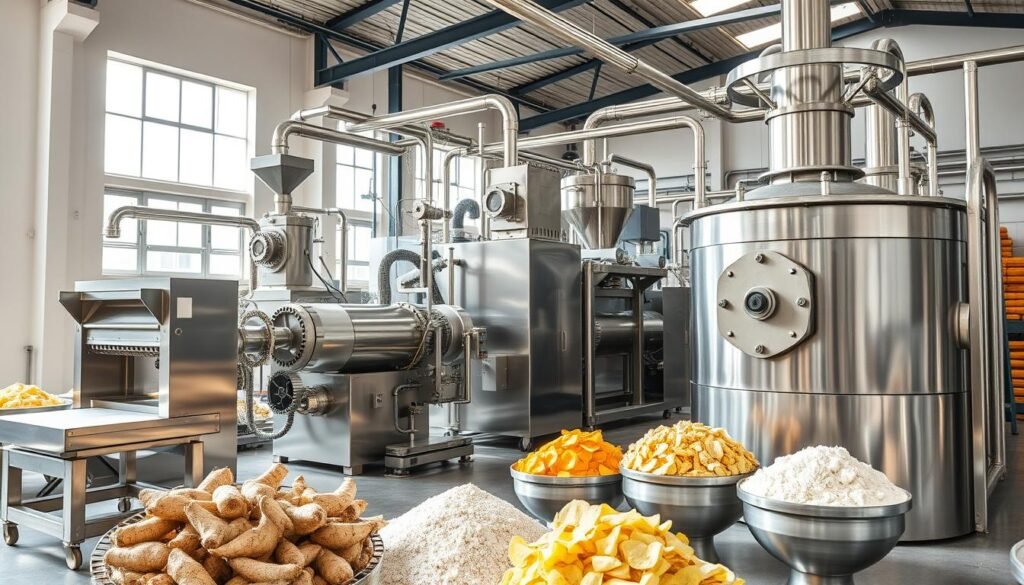
Environmental Impact of Cassava Processing Techniques
The environmental impact of how we process cassava is key to its sustainability. Old methods, like using firewood, harm forests and lead to deforestation. This is a big problem in areas where small farmers grow cassava, mainly in Africa, Asia, and Latin America.
Switching to sustainable cassava processing is vital. Eco-friendly methods and energy-saving tech can cut down on wood use and emissions. For example, new drying methods need less firewood, helping to save forests.
It’s important to think about how cassava farming affects the environment. Farmers often use little fertiliser, leading to low yields. Better farming practices can improve yields and protect soil, reducing erosion by up to 90%.
| Yield (t/ha) | Recommended N (kg/ha) | Recommended P2O5 (kg/ha) | Recommended K2O (kg/ha) |
|---|---|---|---|
| 15 | 80 | 10-20 | 50 |
| 30 | 150 | 20-30 | 150 |
Cassava takes fewer nutrients than other crops, but bad management can still harm soil. It’s important to protect soil and keep nutrients in during cassava’s early growth.
Being aware of the environmental impact of cassava processing can help us move towards a greener future. Most cassava farmers are now using eco-friendly methods. This shows we can grow food sustainably and protect our planet at the same time.
Conclusion
The advancements in cassava processing are key to improving food security and boosting the economy. Africa plays a big role in cassava production, making up 54% to 58% of global output between 2000 and 2013. This shows how vital cassava is for both local communities and the world.
By mixing traditional knowledge with new methods, we’re making the cassava industry more sustainable. In Nigeria, new processing technologies have made peeling and other steps more efficient. This has made the cassava market more profitable and sustainable. We also see cassava’s importance in global trade through products like flour and starch.
Cassava is more than just a food crop; it has huge potential in many industries. As we keep innovating and using the best practices, the future of cassava looks bright. It promises sustainability, profit, and better lives for everyone.
FAQ
What is cassava and why is it important?
Cassava, also known as manioc, is a root vegetable. It’s a staple in many developing countries. Its high calorific value and resilience help ensure global food security.
What are the different varieties of cassava?
There are bitter (toxic) and sweet (non-toxic) types of cassava. Each type is best for different uses, affecting safety and taste.
What are the main techniques used in cassava processing?
Key steps include peeling, grating, fermentation, and drying. These methods are crucial for preparing cassava for various uses.
How does modern harvesting technology improve cassava production?
Modern methods use machinery, boosting productivity and reducing waste. This results in better quality roots and more efficient production.
What products can be made from cassava?
Cassava can be turned into flour and starch. These are used in baked goods, drinks, and more, across different industries.
What are some current trends in the cassava market?
Demand for cassava flour and starch is growing. This is due to the popularity of gluten-free products and sustainable sourcing.
What role do women play in the cassava processing sector?
Women are key in cassava processing, from harvesting to sales. Their work boosts household income and community development.
What should I consider before investing in cassava processing equipment?
Think about the machinery’s fit for local conditions and cost-effectiveness. Also, consider the expected return on investment for successful processing.
How do traditional cassava processing methods impact the environment?
Traditional methods use firewood, leading to deforestation. Modern, sustainable techniques can help reduce these environmental impacts.
What advancements are being made in cassava processing technology?
New technologies aim to improve efficiency, quality, and mechanisation. These advancements help the cassava industry grow and become more profitable.
Source Links
- Chapter 5 – Processing of Roots and Tubers – https://www.fao.org/4/x5415e/x5415e05.htm
- Thailand: Cassava Starch Production | Asean Cassava – https://sustainablecassava.org/national-centre/article/Thailand-Article-2024-5-2/
- The global cassava development strategy and implementation plan – https://www.fao.org/4/y0169e/y0169e04.htm
- 3. Sheela Immanuel.cdr – https://indianecologicalsociety.com/wp-content/themes/ecology/volume_pdfs/1707051241.pdf
- Cassava – https://en.wikipedia.org/wiki/Cassava
- Cassava | Description, Origin, Poison, Taste, Benefits, & Facts | Britannica – https://www.britannica.com/plant/cassava
- Cassava Plant Guide – https://plants.usda.gov/DocumentLibrary/plantguide/pdf/pg_maes.pdf
- Introduction to Cassava Processing – https://cassavavaluechain.com/cassava-processing/
- Progress in research and applications of cassava flour and starch: a review – https://pmc.ncbi.nlm.nih.gov/articles/PMC6542882/
- PDF – https://www.fao.org/fileadmin/user_upload/inpho/docs/Post_Harvest_Compendium_-_Cassava.pdf
- Cassava Processing In Africa – Applications of Biotechnology to Fermented Foods – https://www.ncbi.nlm.nih.gov/books/NBK234676/
- Strategic environmental assessment – https://www.fao.org/4/y2413e/y2413e0d.htm
- CASSAVA STARCH AND FLOUR PROCESSING FACTORIES – https://www.iibdevelopmentgroup.com/business-consortium-africa-region/cassava-starch-and-flour-processing-factories
- Cassava processing – Cassava flour and starch – https://www.fao.org/4/x5032e/x5032e02.htm
- Cassava Flour Market Size & Share | Industry Report, 2030 – https://www.grandviewresearch.com/industry-analysis/cassava-flour-market-report
- Cassava Processing Market – Size & Industry Share | 2034 – https://www.expertmarketresearch.com/reports/cassava-processing-market
- PDF – https://thescipub.com/pdf/ajebasp.2023.13.17.pdf
- PDF – https://www.ajol.info/index.php/lje/article/view/278069/262308
- PDF – https://gnpublication.org/index.php/afs/article/download/325/317/655
- Key points you need to know about cassava flour processing – https://www.linkedin.com/pulse/key-points-you-need-know-cassava-flour-processing-amber-zhao-u4h7c
- Introduction to Different Types of Cassava Processing Plant – https://www.gemfoodtech.com/introduction-to-different-types-of-cassava-processing-plant-equipment/
- Strategic environmental assessment – https://www.fao.org/4/y2413e/y2413e04.htm
- Environmental Effect of Value Addition on Cassava Processing in Etche Local Government Area, Rivers State, Nigeria. – https://www.gjournals.org/2023/09/09/082323094-unaeze-and-nwasiolo/
- Cassava flour and starch: processing technology and utilization – https://biblio.iita.org/documents/S16InbkShittuCassavaNothomDev.pdf-235fd21d0084903cd2035e6936e78ada.pdf
- PDF – https://www.scielo.br/j/cta/a/Jx9SskpDnjGDvBFNsvZ96cG/?format=pdf

